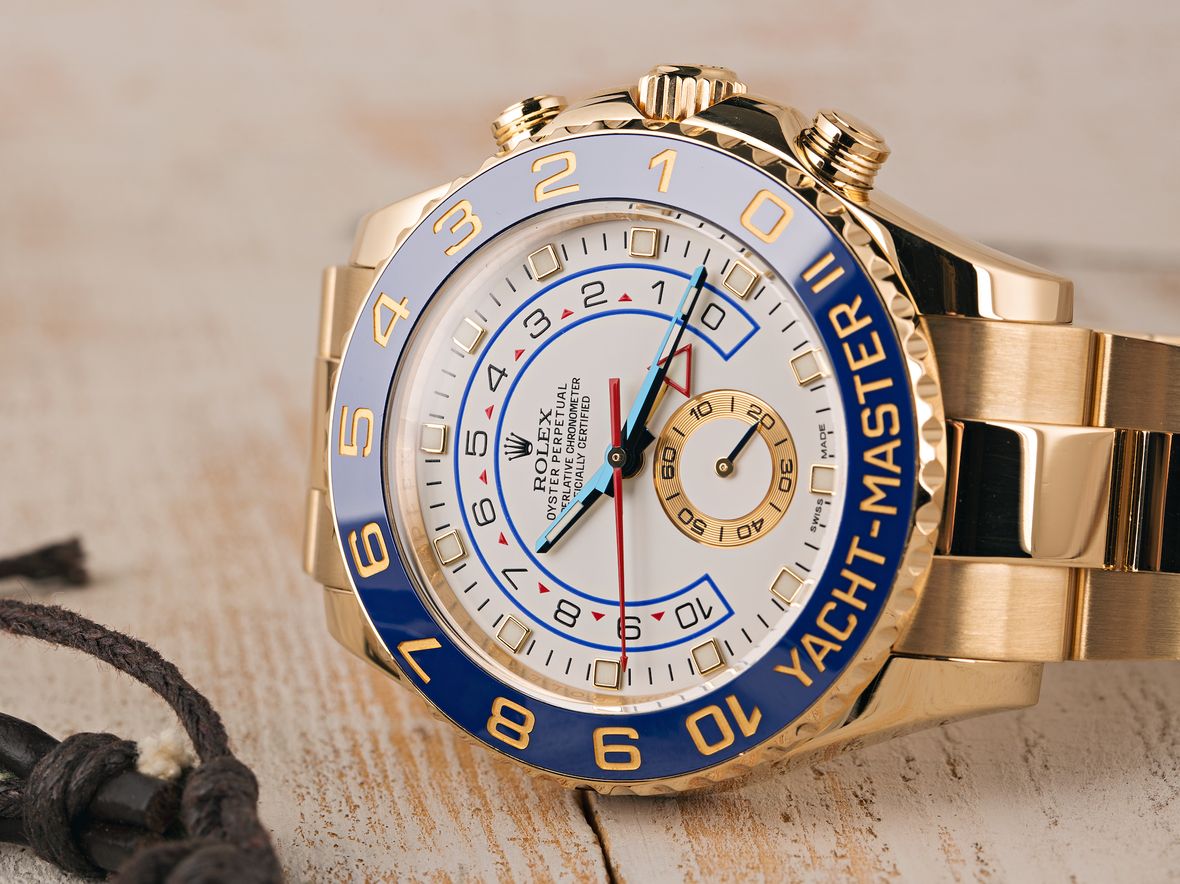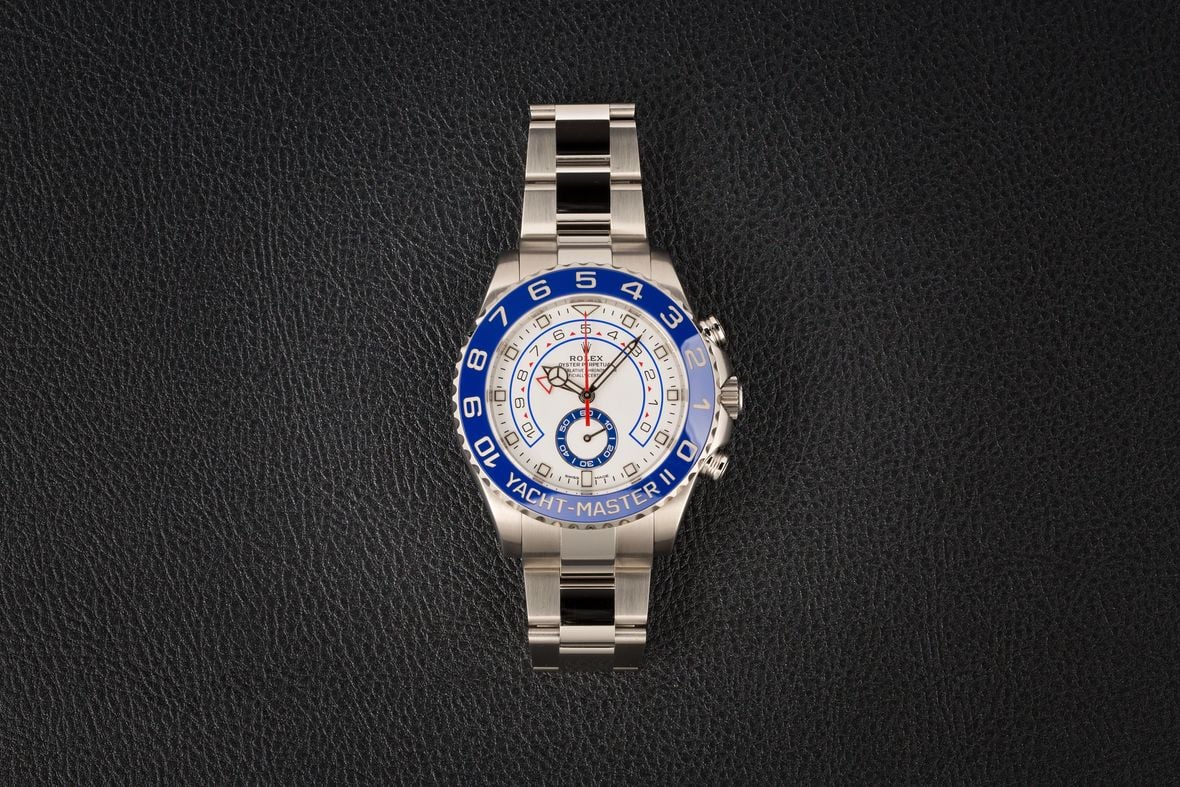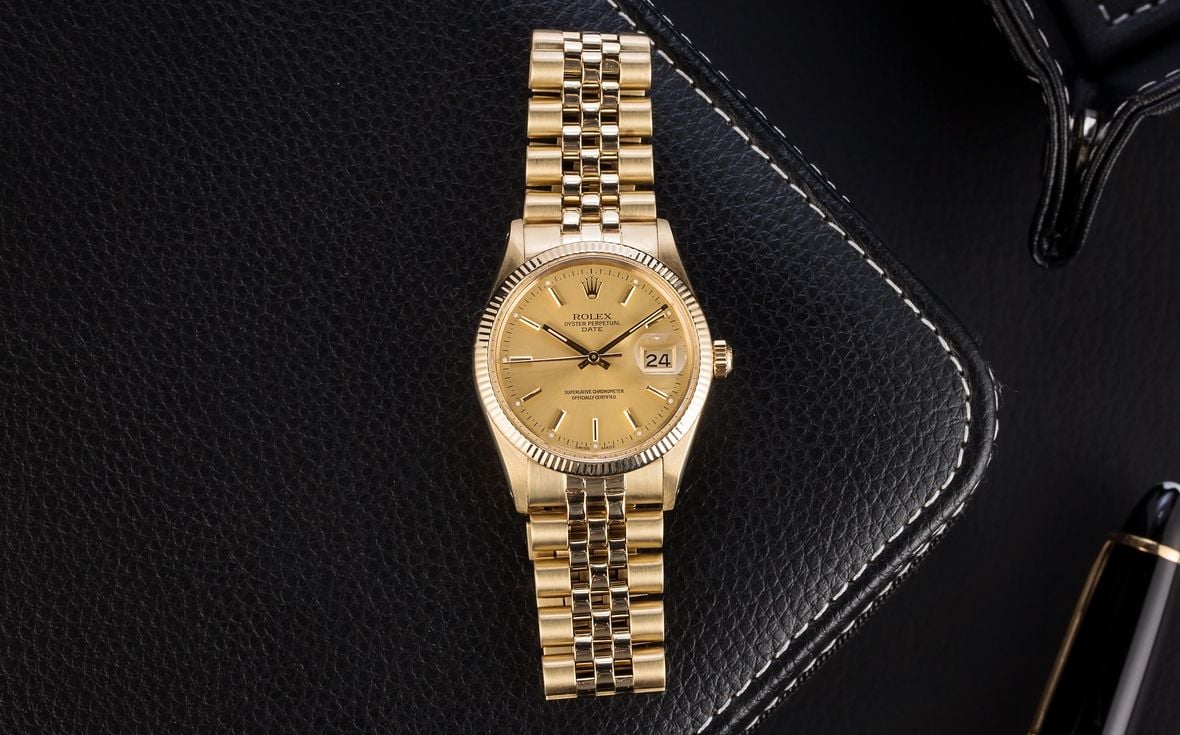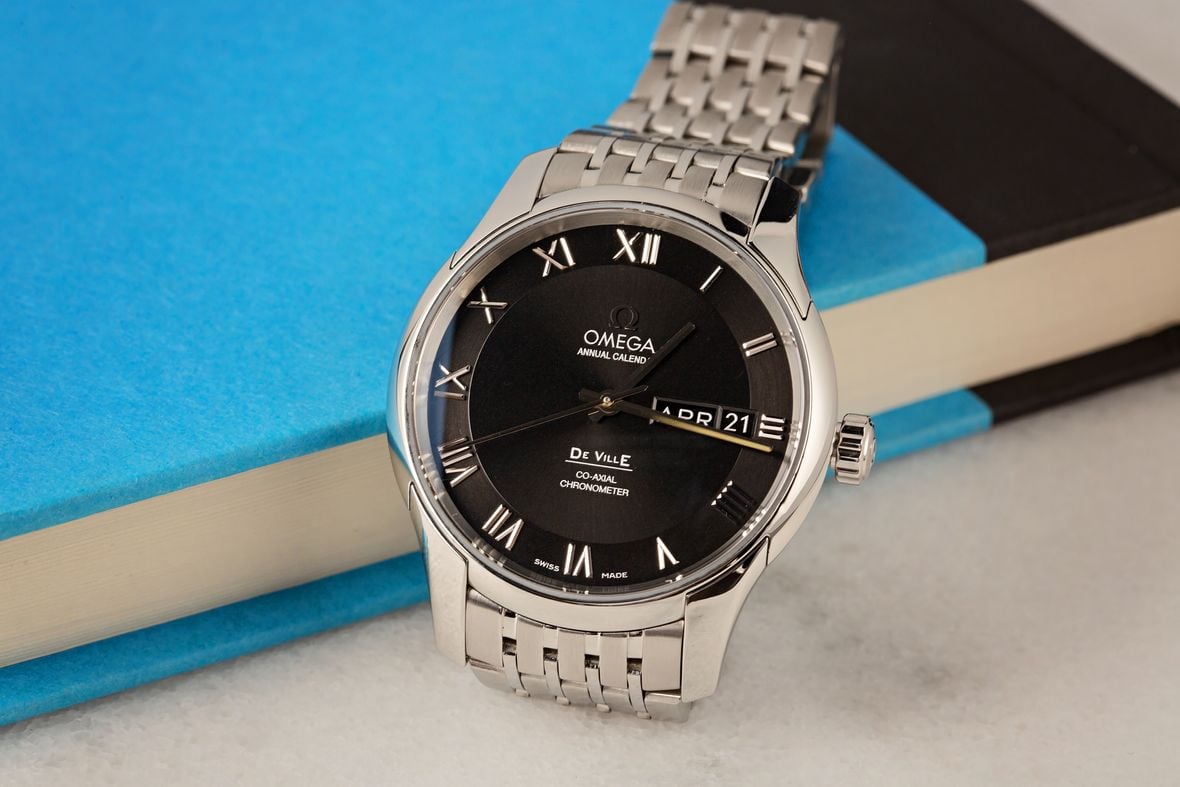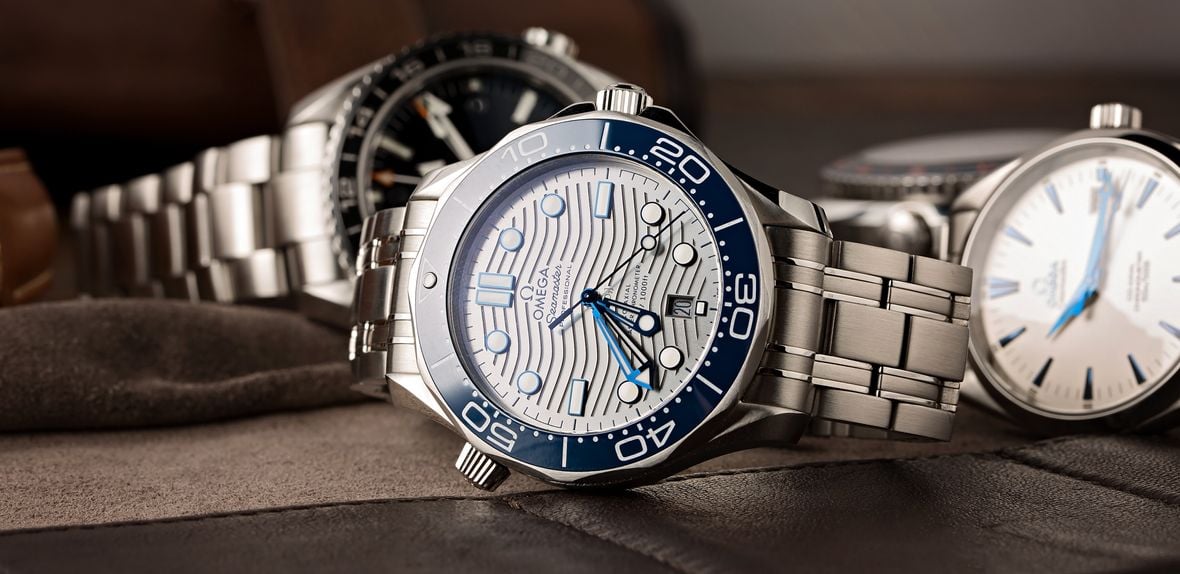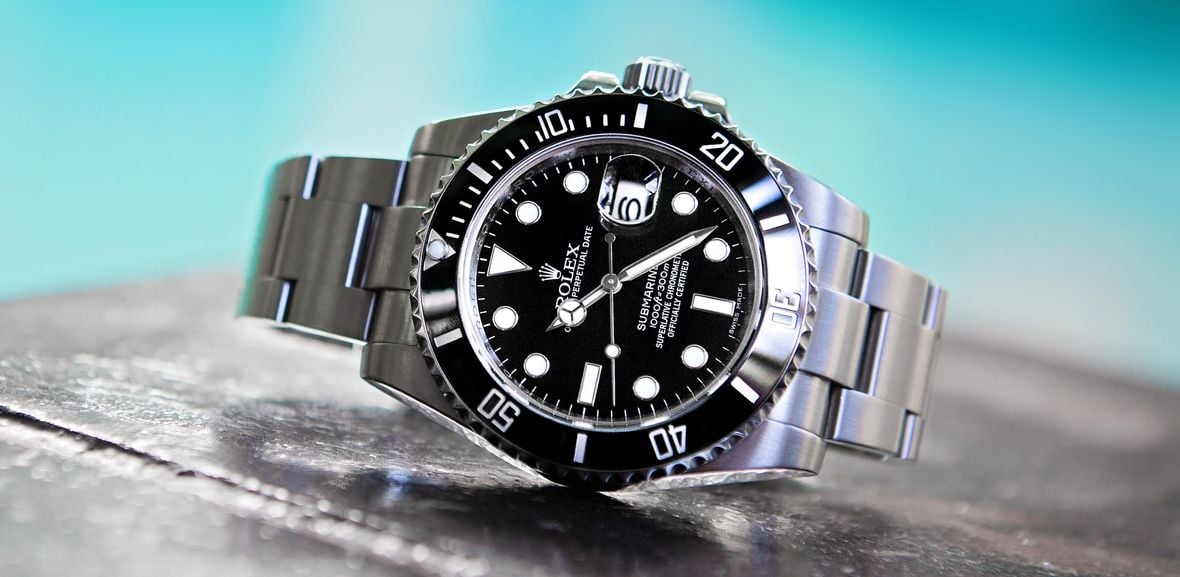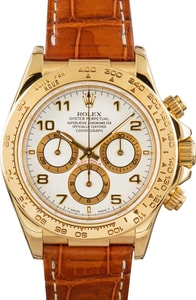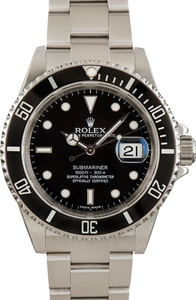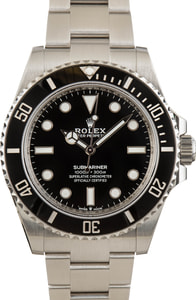There are some Rolex watches that are more or less universally loved, with a simple and versatile aesthetic that leaves little room for any sort of animosity. However, there are others within the portfolio that almost seem to have been created specifically to invite controversy, taking the brand away from its traditional design base and into more contentious territories. The Rolex Yacht-Master II collection is one of those watches.
When it arrived in the mid-2000s, the Yachtmaster II was so far removed from anything Rolex had created before that nobody seemed to know quite what to make of it. The watch was a big, bold and extremely expensive addition to the catalog, and while it was obviously slotted into the brand’s Professional Collection, it stuck out like the proverbial sore thumb. However, that was back then. Looking at the brand’s catalog today, it seems that Rolex was simply ahead of the game.
The Yacht Master II’s once challenging looks have matured, and although it is still most definitely a visually striking watch, it is no longer considered completely over the top. Mechanically, it is also incredibly impressive. On its debut, it instantly became Rolex’s most complicated watch, with a one-of-a-kind functionality aimed at about as niche a group as you could imagine. Below we have laid out a complete guide to the Rolex Yacht-Master II with everything you need to know in order to make an informed decision.
Rolex Yacht-Master II
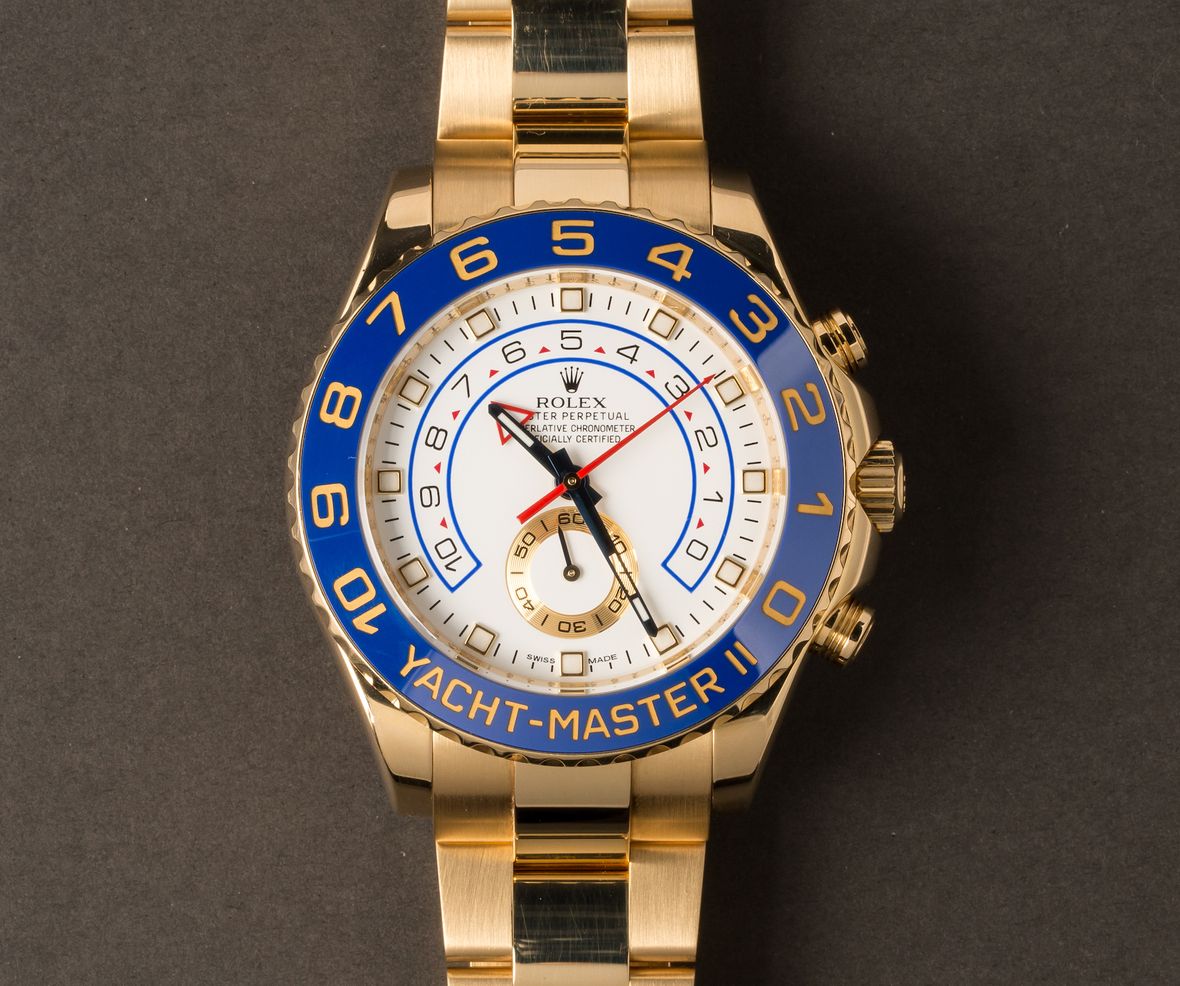
Yacht-Master II Key Features:
– Year Introduced: 2007
– Case Size: 44mm
– Materials: Oystersteel; Everose Rolesor; 18k Yellow Gold; 18k White Gold & Platinum
– Functions: Time w/Running Seconds, Programmable Regatta Timer w/ Mechanical Memory
– Dial: White w/ Luminous Hour Markers
– Bezel: Ring Command, Blue Ceramic or Platinum Insert w/ 10-Minute Countdown Scale
– Crystal: Sapphire (Flat)
– Movement: Rolex Caliber 4161
– Water Resistance: 100 Meters / 330 Feet
– Strap/Bracelet: Oyster Bracelet
– Retail Price: $18,750 – $48,150 USD (Approx.)
For more info, visit our guide on how to use the regatta timer on the Rolex Yacht-Master II.
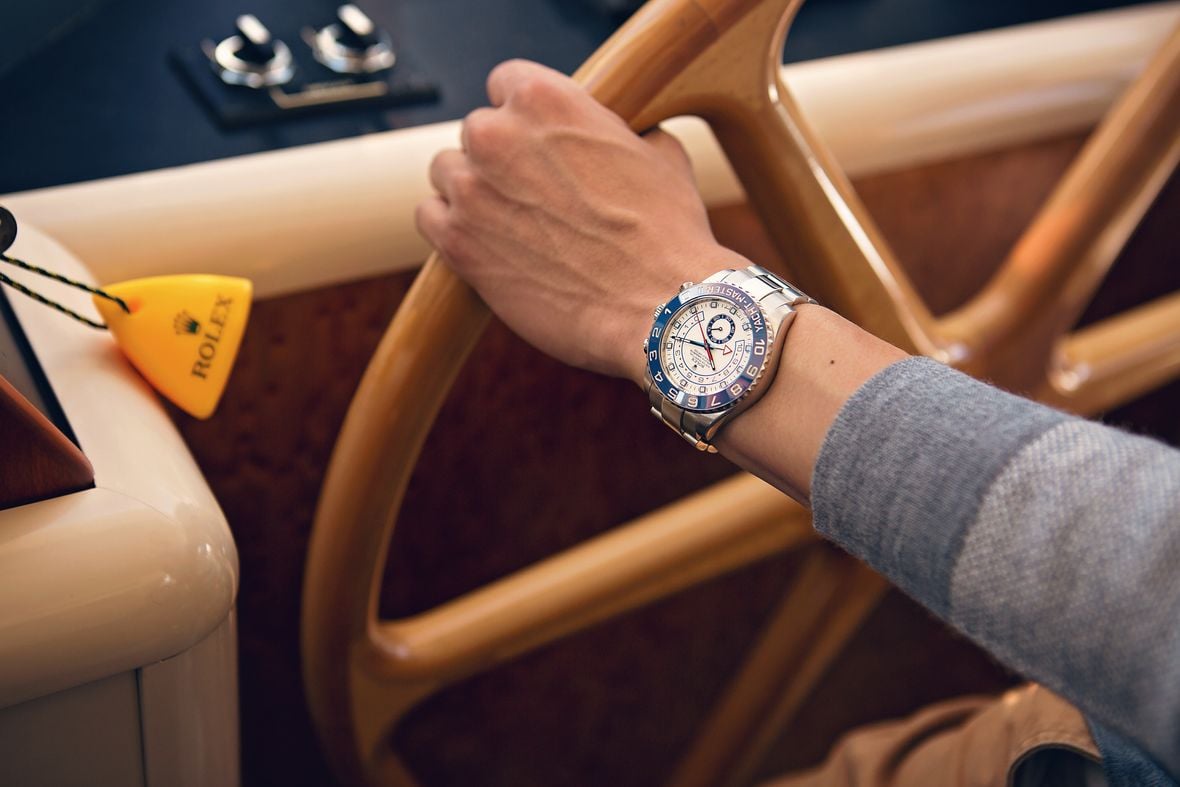
Rolex Yacht-Master II History
Launched in 2007, the Rolex Yacht Master II debuted some 15-years after its original Yachtmaster namesake. However, the similarities between this watch and the model that first carried the Yacht-Master name are pretty much zero.
Where the earlier model is essentially a more luxurious take on the Rolex Submariner, the Yacht-Master II is a fully-fledged item of luxury professional sailing equipment, designed from the outset to assist skippers keep track of time during the complicated starting sequence of a regatta. That technically leaves the Yacht-Master II in the tool watch category, but this is a long way from the likes of the more utilitarian Explorer II and evidence of that can be found in its release schedule.
The first versions of the Rolex Yacht Master II to be unveiled were the 18k yellow gold ref. 116688 and the even more opulent 18k white gold version fitted with a platinum bezel, the ref. 116689. Quite a bit removed from the brand’s usually conservative styling, this large, gleaming, in-your-face effort that shouted its own name across its bezel, was an immediate opinion splitter. Traditionalists were horrified, lamenting Rolex’s continued straying from its roots, while others who enjoy having their watches noticed, embraced it wholeheartedly.
The financial crash that followed in 2008 altered the landscape for watchmakers (along with everyone else) and called for more affordable pieces to come forward. The Yachtmaster II collection expanded in 2011 with the unveiling of the ref. 116681, an Everose Rolesor model with a stainless steel case and outer bracelet links paired with a winding crown, pushers, and central links in Everose gold. That was followed by the version everyone was clamoring for in 2013 – the ref. 116680 in full stainless steel, which also introduced a new caliber, the Cal. 4161, replacing the former Cal. 4160.
The only other change the watch has undergone since then occurred on its 10th anniversary in 2017, when it was given a facelift so slight that Rolex didn’t even feel it warranted a new reference number. The square hour markers at the six and 12 o’clock were changed to a rectangle and inverted triangle respectively, and the simple stick handset was swapped for the Mercedes type to bring them in-line with much of the rest of the brand’s Professional Collection.
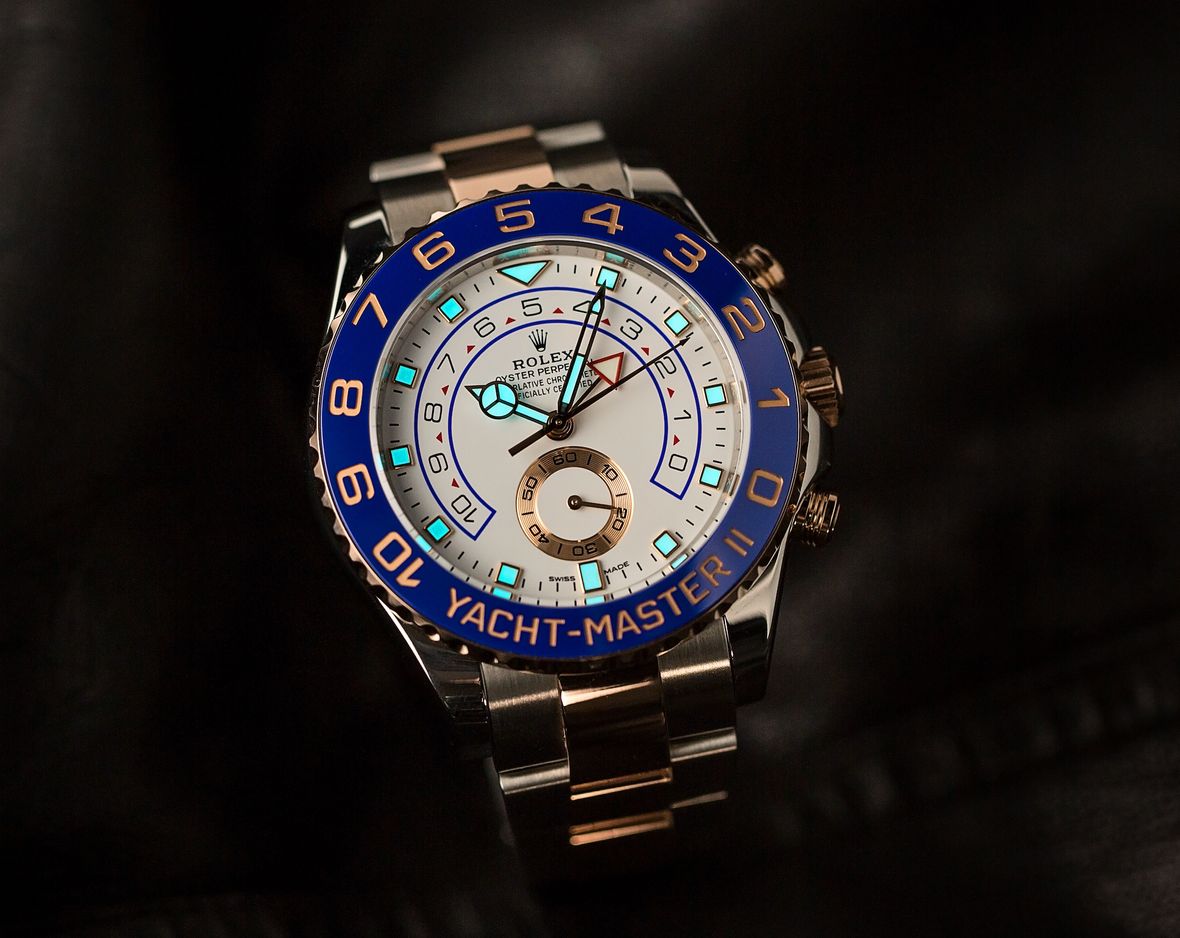
How Much Is A Rolex Yacht-Master II?
When the Rolex Yacht-Master II first arrived, the combination of its exclusively precious metal construction and the extraordinary engineering going on inside its movement meant that it was among the most expensive offerings in Rolex’s catalog. This left many admirers priced out of the picture, but the introduction of stainless steel and two-tone references would soon open the Yacht-Master II up to a much wider range of buyers.
The Rolesor model from 2011 sacrificed some of that wall-to-wall gold for 904L stainless steel and more or less cut the asking price in half, while the full steel version dropped the retail price even further. Today, brand-new examples vary from $18,750 for the full stainless steel model up to $48,150 for the white gold and platinum version. But what about pre-owned prices?
The rather love-it-or-hate-it visuals of the Rolex Yacht Master II means that it doesn’t attract quite the same level of universal frenzy as the Daytona or Submariner. It is not completely out of the question for an authorized retailer to even have a model or two in stock, which isn’t something that can be said about the vast majority of the brand’s other sports watches. For that reason, pre-owned models do command a bit of a premium, but nowhere near as much as some of the other models in the brand’s catalog.
You can expect to pay a minimum of around $18,000 for an unworn steel piece on the secondary market, while the Everose Rolesor edition comes in closer to about $25,000. The 18k yellow gold ref. 116688 also holds pretty steady, with most examples falling somewhere in the $40,000 to $45,000 range, depending on age and overall condition. Finally, the ref. 116689 – the top-of-the-line model in white gold and platinum, is where the biggest discounts can be found. A brand-new example costs $48,150 at an authorized dealer, but an older example on the pre-owned market can often be found for just under $30,000.
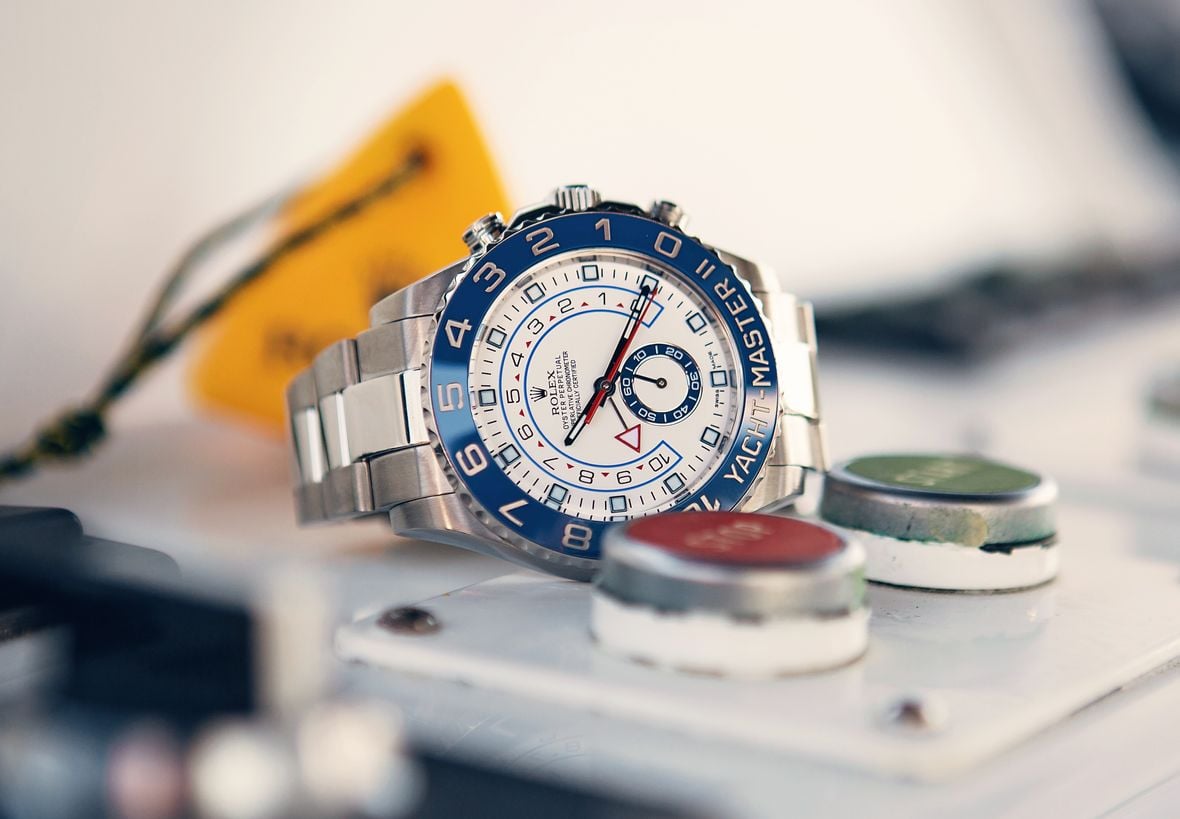
Rolex Yacht-Master II Design
The Yacht-Master II is arguably the least “Rolex-looking” Rolex watch ever made, which is the core reason behind why it ruffled so many feathers among purist collectors upon its release. It’s arrival took the brand down previously unexplored experimental paths, a very far cry from the sort of discreetly restrained icons present throughout the rest of its portfolio.
The Yacht-Master II is a hard-working watch with a lot of information to present and as a result, it has what initially looks like somewhat of a cluttered dial. However, a lot of that is down to a trick of the eye concerning the bezel’s 1-10 numerals being mirrored exactly around the horseshoe-shaped track on the face. This is obviously the regatta countdown scale, designed to help yacht skippers synchronize their boats’ movements with the race’s starting gun (we’ll get onto this more a little later).
What it means for the overall styling is a lot of numbers on the watch that you will not be using for the vast majority of the time you are wearing it. But while it may come across as a little jam-packed – particularly when you add in the chronograph hand, arrowhead countdown pointer, and a small running seconds sub-dial at the bottom – once you get used to it, you can’t help but be impressed with how much Rolex’s technicians have achieved with so little. No, it isn’t exactly the Explorer’s 3/6/9 arrangement, but it is perfectly readable with a little familiarity and conveys the information it provides in a clean and legible manner.
Despite only containing four models (all of which have white dials), the series actually covers a good range of tastes. The ref. 116688 could be in the running for most showy standard-production Rolex currently available, its all-yellow gold case somehow making the bright blue bezel pop even more. At the other end, the white gold and platinum ref. 116689 is as low-key and reserved as a 44mm wide, 14mm thick, highly-complicated, solid-gold sports watch can be. The virtual monochrome is lifted only by the red chrono hand and arrowed pointer.
In-between, the stainless steel and Everose Rolesor models do the job of appealing to more middle-of-the-road palates. Their color combinations, along with the mix of brushed and polished elements on the watch itself, keep it all on the right side of overdone, and the two-tone model’s bezel numerals also being filled in Everose gold is a nice touch. Unlikely to ever be described as subtle, any version of the Rolex Yacht-Master II is guaranteed to receive some attention.
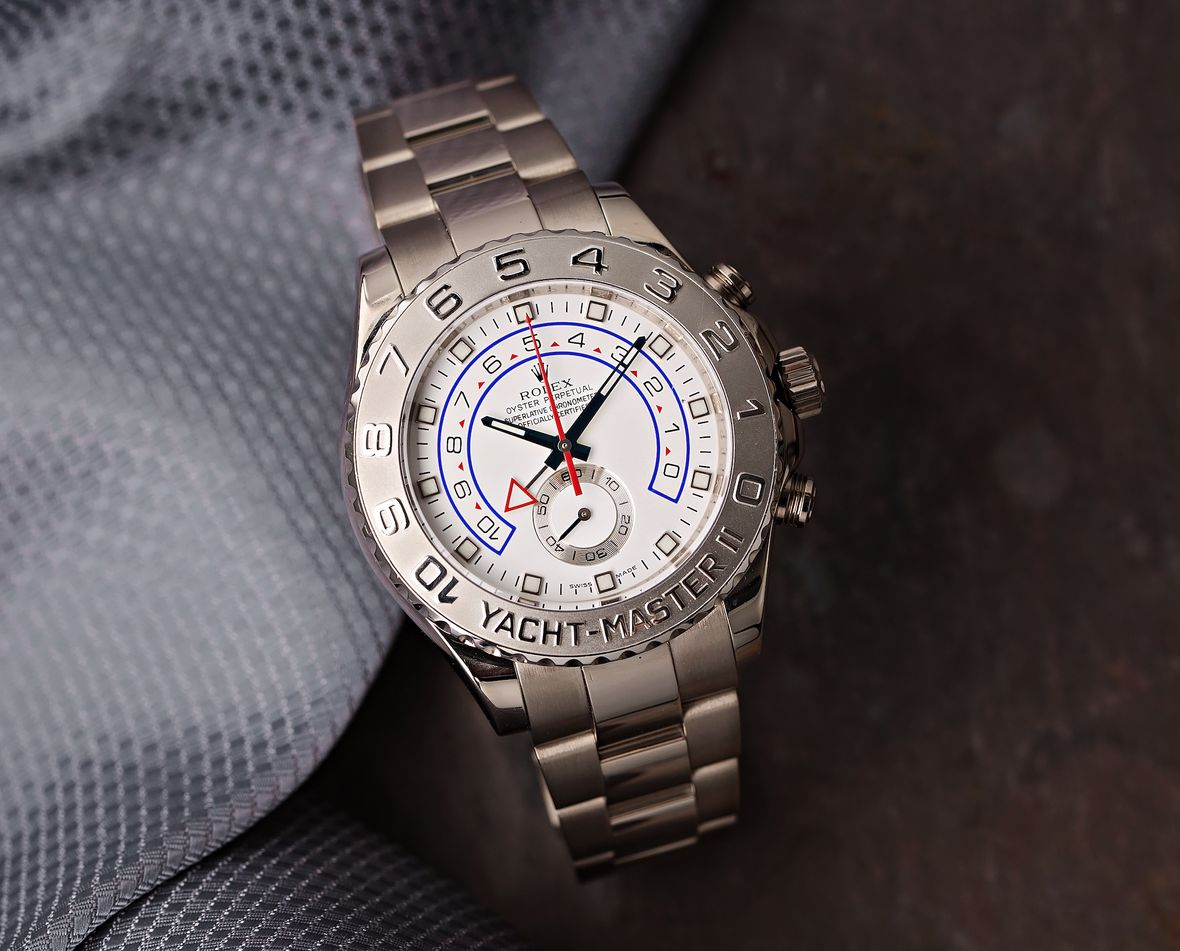
Rolex Yacht-Master II Functions
Looks aside, the big talking point around the Rolex Yacht Master II lies in what it can do. There is a strong argument against calling the watch a genuine chronograph as it doesn’t so much keep track of elapsed time in the traditional sense, as it does count backwards from a specific starting point, up to a maximum of 10-minutes.
How is that useful? It is all down to how a professional regatta gets underway. Due to the nature of wind and water, it simply isn’t possible to get a bunch of yachts all lined up at a particular spot in the ocean and have them set off at the same time. Instead, the start of a race goes in stages, with each one marked by a gunshot or other audible signal. The first is usually sounded 10-minutes before the start (although it can also be seven or even five), and the skippers must maneuver their boats back and forth in front of the line without crossing it, jockeying with the other competitors for prime position.
There follows two further preparatory signals at precise intervals, and crews must coordinate their approach so they are as close to the start point as possible at the exact moment the race officially begins. It is that pair of additional signals that call into action one of the party tricks of the Yacht-Master II’s unique complication. Should the watch fall out of sync with the regatta reference clock for any reason, a press of the lower pusher activates the flyback (or fly-forward) function, snapping the chronograph hand to the nearest minute to allow the two timers to match up again. Even more notably, it is the only mechanical watch in the world with a programmable memory, meaning the wearer can reset back to the specified original countdown point at any time.
Giving access to all this engineering virtuosity is what Rolex has dubbed its Ring Command Bezel. This was the first appearance of the concept, with the second generation taking control of the Sky-Dweller’s myriad of functions a few years later. On both models, the bezel is directly linked to the internal movement, and on the Yacht-Master II, it acts as an analogue on/off switch. Rotating it 90° unlocks the functionality and allows for the countdown timer to be set with the crown. Turning it back again locks everything in place, and engages the memory. The watch is then operated as a standard chronograph, with the top pusher activating the starts and stops, and the bottom taking charge of the reset or flyback/fly-forward functions.
For a manufacturer not renowned for the complexity of its watches (quite the opposite, in fact) Rolex’s regatta timer is a seriously impressive performer. It may have been created for an especially select group, but it is truly surprising how useful it can be to count down accurately from 10-minutes, even for those of us who may not own a yacht – particularly if you like your pasta al dente.
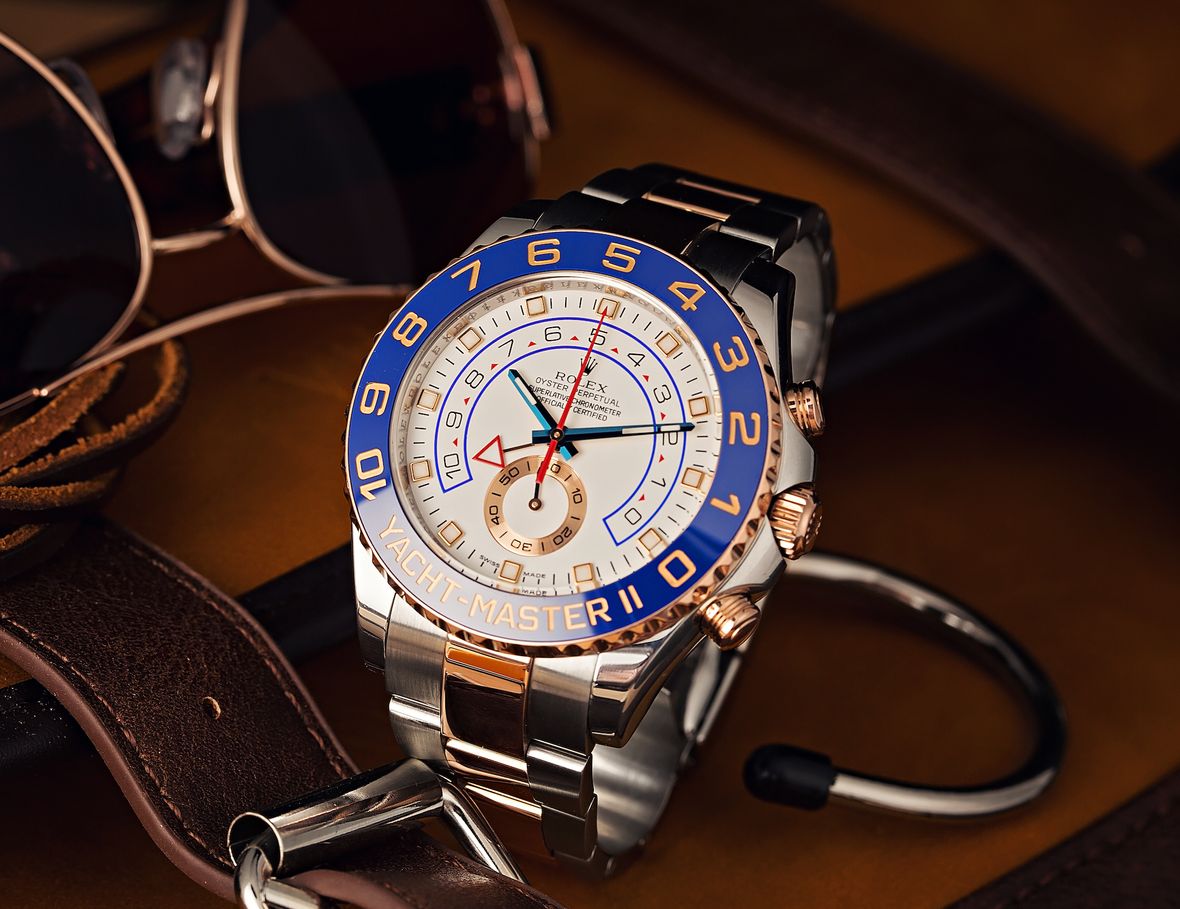
Rolex Yacht-Master II Movement
The first run of the Rolex Yacht-Master II was powered by the in-house Caliber 4160. At the time, it was the most component-heavy movement the brand had ever created, but it was essentially a heavily reworked version of the Cal. 4130 from the Daytona. The column wheel, vertical clutch and ball-bearing rotor were all carried over from the brand’s legendary racing chronograph.
Obviously there is nothing wrong with that, and the Rolex Daytona’s movement remains one of the most reliable and accurate mass-produced chronograph calibers of the modern era. However, with the arrival of the long-awaited stainless steel Yacht-Master II in 2013, Rolex also unveiled a new mechanism, the Caliber 4161, the product of additional refinements and some 35,000 hours of development.
Made up of over 360 components, including those produced via a highly specialized fabrication process called UV-LiGA which uses ultraviolet light to build microstructures, this dedicated movement provided a crisper feel to the pushers and greater reliability. With that in mind, both the Cal. 4160 and the Cal. 4161 benefitted from Rolex advances such as the blue Parachrom hairspring, as well as providing users with a highly-respectable 72-hour power reserve and a 28,800vph balance frequency.
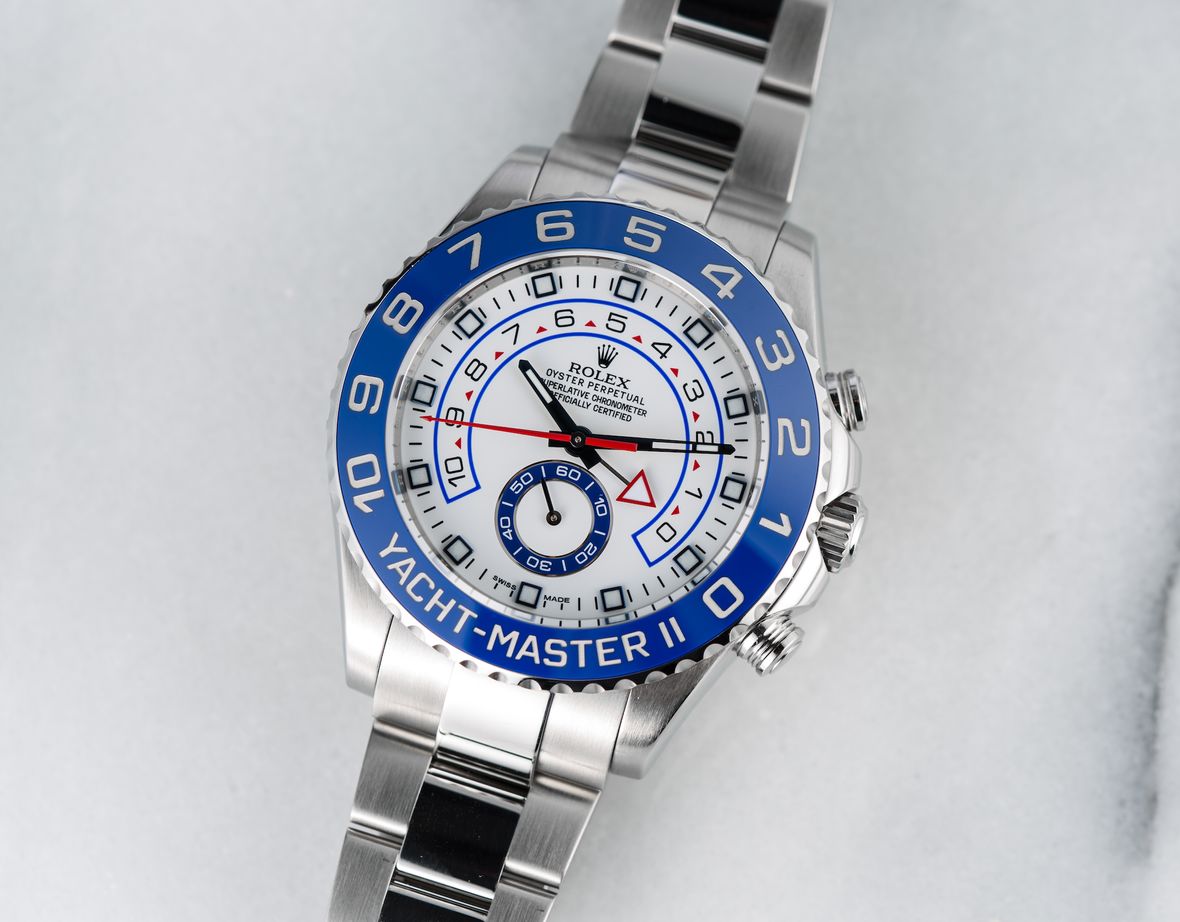
Rolex Yacht-Master II Bracelet
At the present time, all of the various Rolex Yacht-Master II models are fitted with the three-link Oyster bracelet, as befits a true sports watch. On each version, the inner links have been given a high polish to match the gleaming case, while the outer links receive a satin finish to provide a contrast against the lugs.
As for material, the bracelet is crafted from the same metal as the watch head: stainless steel, yellow gold or white gold. With the Rolesor example, the innermost links are forged from Everose gold, leaving the outer side links in 904L stainless Oystersteel. Tying it all together is the Oysterlock folding clasp, equipped with the brand’s Easylink extension system that allows for approximately 5mm of tool-free bracelet adjustment, completely on the fly and without the use of any tools.
The Yacht-Master II was something of a retaliation from Rolex against decades-worth of naysayers criticizing the brand for the lack of complicated watches in its lineup. Rolex’s rebuttal, while not the most all-encompassing in terms of looks or utility, still stands as a hugely significant piece of technical dexterity. Rolex has always produced tool watches, but as the company continues to make the transition towards being a true luxury manufacturer, the tool watches it produces also take on a more luxurious nature and the Yacht-Master II perfectly embodies this. Large and uncompromising, it is perhaps the most eccentric model Rolex has to offer – and it is always happy to take center stage.
